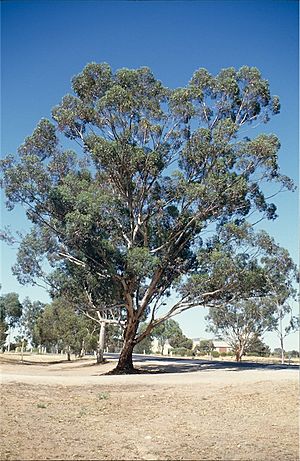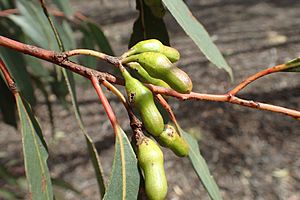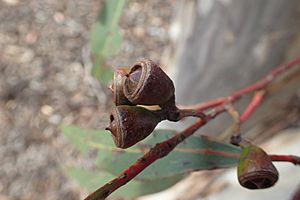Brown mallet facts for kids
Quick facts for kids Brown mallet |
|
|---|---|
 |
|
| Eucalyptus astringens growing at Loxton, South Australia | |
| Scientific classification | |
| Genus: |
Eucalyptus
|
| Species: |
astringens
|
The Brown Mallet (scientific name: Eucalyptus astringens) is a special type of tree. It is also known by the Noongar people as mallat, woonert or wurnert. This tree grows naturally only in the South West part of Western Australia.
Brown mallet trees have smooth, shiny bark on their trunks and branches. Their leaves are shaped like a spear. They have flower buds that hang down in groups of seven. When they bloom, their flowers are cream-coloured or pale lemon. After flowering, they produce fruit that looks like a cup or bell. This tree has also been planted in Victoria.
Contents
What the Brown Mallet Looks Like
This tree usually grows to be about 1.5 to 15 metres (5 to 49 feet) tall. Some can even reach up to 24 metres (79 feet)! It has smooth, grey-brown bark that peels off its trunk and branches.
Brown mallet trees bloom from August to December. Their flowers are white, cream, or yellow. The trunk of a mature tree can be about 7 metres (23 feet) wide at chest height. This tree is good at handling dry weather. It grows well in places that get about 300 to 400 millimetres (12 to 16 inches) of rain each year.
The adult leaves are shiny green on both sides. They grow in an alternating pattern along the stem. Each leaf is shaped like a spear, about 6 to 14 centimetres (2.4 to 5.5 inches) long and 1 to 3.5 centimetres (0.4 to 1.4 inches) wide.
The flowers grow in groups of seven. The buds are short and thick or long and thin. The fruits that form later are shaped like a cup or bell. Each fruit is about 1.2 centimetres (0.5 inches) long and 1 centimetre (0.4 inches) wide. Inside, they have three or four parts that hold grey-black seeds.
How the Brown Mallet Got Its Name
The Brown Mallet was first officially described in 1911 by a scientist named Joseph Maiden. He first called it Eucalyptus occidentalis var. astringens. Later, in 1924, Maiden decided it was unique enough to be its own species. So, he changed its name to Eucalyptus astringens.
The second part of its scientific name, astringens, is a Latin word. It means "shrinking" or "binding."
In 2002, two other scientists, Ian Brooker and Stephen Hopper, found two slightly different types of Brown Mallet. These are called subspecies:
- Eucalyptus astringens subsp. astringens: This is the taller type of brown mallet. Its flower buds are usually longer than 15 millimetres (0.6 inches).
- Eucalyptus astringens subsp. redacta: This is a smaller type of brown mallet. It has smaller buds and fruit compared to the first type.
Where the Brown Mallet Grows
You can often find the Brown Mallet in rocky areas. It grows on ridges, hills, and in valleys. These areas are in the southern Wheatbelt, Great Southern, and south-west Goldfields-Esperance regions of Western Australia.
It likes to grow in different types of soil. These include red-brown gravelly clay, brown clayey sand, sandy loam, and soils based on laterite and sandstone.
Sometimes, the Brown Mallet grows near another tree called E. wandoo. They often form woodlands together. Other plants that might grow nearby include some grasses and herbs.
The Brown Mallet has also started growing in new places where it wasn't originally found. For example, it has become naturalised in Bacchus Marsh, which is north of Melbourne in Victoria. It was first planted there to help keep the soil from washing away.
Uses of the Brown Mallet
The wood from the Brown Mallet tree is very useful. People use it for building things, for wood in mines, and for making tool handles. It also makes good firewood.
The bark of the tree is special because it contains a lot of tannin, about 40%. Tannin is a substance that can be used to treat leather. It might also be used to make glues.
Around 8,000 hectares (20,000 acres) of Brown Mallet trees have been planted. These plantations are near Narrogin in Western Australia. They are grown specifically to produce timber.





